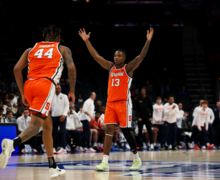‘Liberal bias’ debate on college campuses may encourage open discourse
Corey Henry | Photo Editor
The larger debate around censorship and bias on college campuses should not be based on asking whether liberal bias exists at college or not.
For over a year, students on campus were working to get a Young Americans for Freedom chapter approved. The Young Americans for Freedom is a nationwide political organization of college students that is based on conservative values.
Back in February, the university rejected the proposed YAF chapter for its lack of a faculty adviser and its requirement that members agree to the “superiority” of the U.S. constitution. Some students have alleged that liberal bias directly impacted the group’s efforts to become a recognized student organization, which it now is.
When campus communities discuss bias in education, they have to be honest about what is going on and far more expansive in their discussion. Bias in education does exist, but it is not new, and it is not solely political.
Our nation has seen racial bias, economic bias and geographic bias in all forms of education for more than a century. If we are going to have a productive discussion, we all must be aware of educational bias’s troubled past and how we can fix it so we can ensure a better future.
The right to free speech is absolute and is not a privilege for one demographic or one political group. Today, too many political arguments lead to disrespect, ad hominem attacks and either group wanting to silence the other.
Today in the United States, many posit that our colleges have become breeding grounds for liberal indoctrination. There are many who claim that the higher education system is built to support and spread one ideology, while simultaneously silencing the other.
SU political science professor Mark Rupert said college professors strive to be honest about their perspectives.
“My commitment to my students most fundamentally is to be honest,” Rupert said. “My duty to students is to be as honest as I can be about what I think the truth is.”

Eva Suppa | Digital Design Editor
The larger debate around censorship and bias on college campuses should not be based on asking whether liberal bias exists at college or not. Instead, we should be asking to what degree liberal bias exists at American universities and at what point that bias becomes dangerous. If we focus on that question, we can have a more productive discussion.
Timothy Garton Ash, a professor of European Studies at Oxford University, created “The Ten Principles of Free Speech.” Garton Ash writes that all human beings “must be free and able to express ourselves, and to seek, receive and impart information and ideas, regardless of frontiers,” and that “we express ourselves openly and with robust civility about all kinds of human difference.”
We ought to embrace Professor Garton Ash’s principles in our political discussion.
Harvard University professor Neil Gross conducted a study of 1,417 full-time faculty that found more consider themselves moderate than either liberal or conservative. Studies have also found that the differences in political ideology varied widely among fields, with business and economics being more conservative and the liberal arts being more liberal.
It is unarguable that there has been liberal bias in higher education, but it is wrong to generalize all colleges as inherently liberal and to characterize professors and administrators as tools to systematically push a liberal agenda.
Most professors do not go through years of higher education just to indoctrinate the youth, and anyone who pushes that argument likely has a political agenda of their own. The fact of the matter is that there are college communities that are over all parts of the political spectrum.
Oftentimes when liberal bias in higher education is discussed, many point to how liberal bias has trended upward since the 1950s, but it is also fair to say that the nation as a whole has grown to become more liberal since the 1950s. Since 1992, the percentage of Americans identifying as liberal has risen from 17% then to 26% today.
In our current political climate, there are some students who claim they are victims of a liberal system that is intent on “indoctrinating” their peers. The goal of this self-victimization is to convince people that there are entrenched powers with liberal bias who intend to stamp out opposing viewpoints. This has proven to be destructive because it adds to the growing tribalism in our political climate.
Adding the YAF chapter to campus expands the political diversity and the opportunity for diversity of thought. Diversity is a foundational part of education, and as students, we should all be willing and able to embrace diversity of thought.
David Bruen is a freshman political science and policy studies major. His column appears bi-weekly. He can be reached at drbruen@syr.edu. He can be followed on Twitter @David__Bruen.
Published on October 20, 2019 at 11:26 pm






